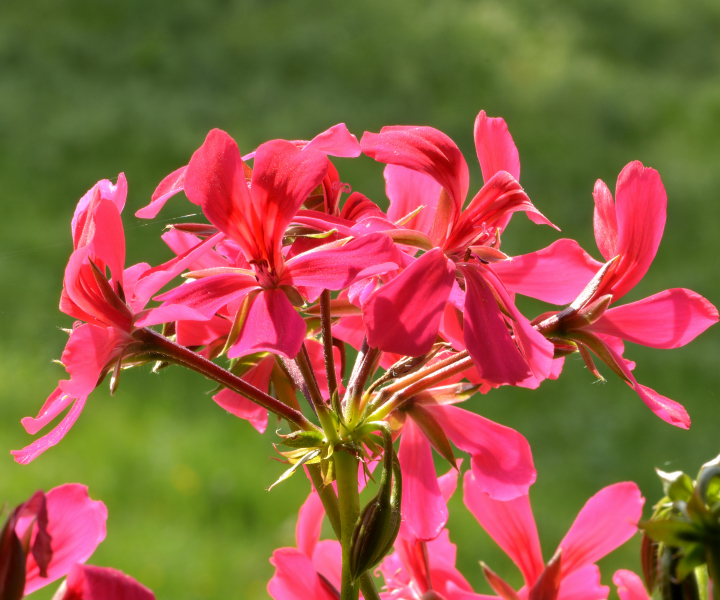The Geraniaceae family, commonly known as the geranium family, is a group of flowering plants in the order Geraniales, consisting of around 5 genera and over 800 species. This family includes primarily herbaceous plants and shrubs, many of which are valued for their ornamental flowers and the aromatic properties of their leaves and flowers. Geraniums are among the most popular garden plants, known for their vibrant colors and adaptability to various environments.
General Description
Plants in the Geraniaceae family share several common characteristics:
- Leaves: The leaves are generally simple or lobed, with serrated or toothed edges. They are arranged alternately and have a fleshy or velvety texture, with aromatic glands that release essential oils responsible for the characteristic scent of these plants.
- Flowers: Flowers are typically five-petaled, often with a symmetrical or star-like arrangement. The colors can vary greatly, with shades of pink, red, white, and purple. Flowers are usually arranged in clusters and are highly attractive to pollinators such as bees and butterflies.
- Fruits: The fruits are typically capsules containing numerous small seeds. In some species, the fruits have a characteristic beak-like shape that helps in wind dispersal of the seeds.
- Stems and Roots: The majority of species are herbaceous, but some species like Fuchsia are woody shrubs. The plants generally have fibrous root systems, and in some species like the geranium, taproots are also present.
Chemical Composition
The Geraniaceae family is known for the production of aromatic compounds, particularly in its flowers and leaves, as well as for its medicinal properties:
- Essential oils: Species like Pelargonium are rich in essential oils, which contain compounds such as geraniol, citronellol, and linalool, contributing to their fragrance and antimicrobial properties. Geranium essential oil is widely used in aromatherapy and cosmetics.
- Flavonoids: Many species in the family contain flavonoids, known for their antioxidant and anti-inflammatory properties.
- Tannins: Some species produce tannins, which are astringent compounds with antimicrobial and anti-inflammatory properties.
- Fatty acids: Some geranium species produce fatty acids, which are important for their therapeutic and nutritional properties.
Physical Properties
The plants in the Geraniaceae family are typically herbaceous or shrubby, and they exhibit the following physical traits:
- Flowers: The flowers are usually large and showy, with five petals arranged symmetrically or in a star-like shape. The flowers are most commonly found in shades of pink, red, or white.
- Fruits and Seeds: The fruits are generally capsules, often with a characteristic beak-like shape that aids in seed dispersal by wind. The seeds are usually small and numerous.
- Leaves: The leaves are generally simple, with serrated or lobed edges, and are often aromatic due to the release of essential oils from glandular cells.
- Roots: Many species in the Geraniaceae family have fibrous or taproot systems. Oenothera species, for example, are known for their taproots, which help in nutrient storage.
Production Process
Some species in the Geraniaceae family are cultivated for their essential oils and ornamental purposes:
- Geranium oil (Pelargonium spp.): Geranium essential oil is extracted from the leaves and flowers via steam distillation. It is widely used in cosmetics for its moisturizing and toning properties, as well as in aromatherapy for stress relief and relaxation.
- Ornamental Geraniums (Geranium spp.): Geraniums are primarily grown as ornamental plants for their vibrant flowers. They are commonly used in flower beds, hanging baskets, and as balcony plants.
Applications
Medicinal
The Geraniaceae family is well-known for the medicinal properties of some of its species:
- Geranium oil (Pelargonium spp.): Geranium essential oil is used for its antibacterial, anti-inflammatory, and antimicrobial properties. It is commonly used in skin care products to treat acne and other skin infections.
- Anti-inflammatory effects: Geranium essential oil is also used to improve circulation and alleviate digestive disorders.
- Antioxidant properties: The flavonoids found in geranium species are known for their antioxidant effects, helping to protect the skin from oxidative damage.
Culinary
The Geraniaceae family is not widely used in culinary applications, though some species, particularly those with aromatic leaves, may be used to flavor dishes or beverages in certain culinary traditions. For example, some varieties of geranium are used to flavor desserts, ice creams, or teas.
Ornamental
Many species in the Geraniaceae family are prized for their ornamental flowers:
- Geraniums (Pelargonium spp.): Geraniums are among the most popular garden plants, grown for their colorful flowers. They are commonly used in flower beds, hanging baskets, and window boxes.
- Fuchsia (Fuchsia spp.): Although not directly related to Geranium, fuchsia plants are often included in the Geraniaceae family and are grown for their pendulous, colorful flowers, making them a favorite in gardening.
Environmental
Plants in the Geraniaceae family can play important roles in the environment:
- Soil stabilization: Some species of geraniums are used for soil stabilization, especially in areas prone to erosion, due to their adaptability to poor or dry soils.
- Pollinator attraction: The flowers of many Geraniaceae species are highly attractive to bees and other pollinators, which depend on these plants for nectar.
Environmental and Safety Considerations
Plants in the Geraniaceae family are generally considered safe for ornamental and medicinal uses, but there are some safety considerations:
- Sustainability: The commercial production of geranium essential oil should be managed sustainably to avoid overharvesting and ensure the conservation of these plants.
- Allergies: Some individuals may be sensitive to the essential oils or pollen produced by species in the Geraniaceae family, which could lead to skin irritation or respiratory issues.
INCI Functions
- Anti-inflammatory: Reduces inflammation and soothes the skin.
- Antioxidant: Protects the skin from oxidative stress.
- Antimicrobial: Helps to combat harmful microorganisms on the skin.
- Soothing: Calms irritated skin and reduces redness.
Conclusion
The Geraniaceae family is an important botanical group, valued for its ornamental beauty, medicinal properties, and oil-rich seeds. Species such as Pelargonium (geranium) are widely cultivated for their colorful flowers and essential oils, rich in beneficial compounds like geraniol.
![]() Geraniaceae
Geraniaceae 
